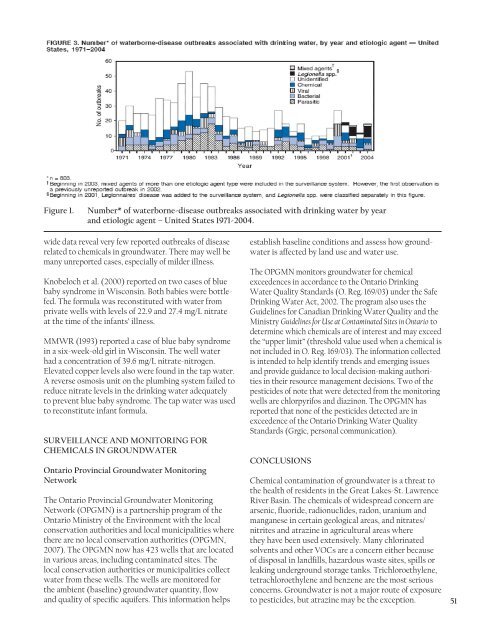Groundwater in the Great Lakes Basin
Groundwater in the Great Lakes Basin
Groundwater in the Great Lakes Basin
Create successful ePaper yourself
Turn your PDF publications into a flip-book with our unique Google optimized e-Paper software.
Figure 1.<br />
Number* of waterborne-disease outbreaks associated with dr<strong>in</strong>k<strong>in</strong>g water by year<br />
and etiologic agent – United States 1971-2004.<br />
wide data reveal very few reported outbreaks of disease<br />
related to chemicals <strong>in</strong> groundwater. There may well be<br />
many unreported cases, especially of milder illness.<br />
Knobeloch et al. (2000) reported on two cases of blue<br />
baby syndrome <strong>in</strong> Wiscons<strong>in</strong>. Both babies were bottlefed.<br />
The formula was reconstituted with water from<br />
private wells with levels of 22.9 and 27.4 mg/L nitrate<br />
at <strong>the</strong> time of <strong>the</strong> <strong>in</strong>fants’ illness.<br />
MMWR (1993) reported a case of blue baby syndrome<br />
<strong>in</strong> a six-week-old girl <strong>in</strong> Wiscons<strong>in</strong>. The well water<br />
had a concentration of 39.6 mg/L nitrate-nitrogen.<br />
Elevated copper levels also were found <strong>in</strong> <strong>the</strong> tap water.<br />
A reverse osmosis unit on <strong>the</strong> plumb<strong>in</strong>g system failed to<br />
reduce nitrate levels <strong>in</strong> <strong>the</strong> dr<strong>in</strong>k<strong>in</strong>g water adequately<br />
to prevent blue baby syndrome. The tap water was used<br />
to reconstitute <strong>in</strong>fant formula.<br />
SURVEILLANCE AND MONITORING FOR<br />
CHEMICALS IN GROUNDWATER<br />
Ontario Prov<strong>in</strong>cial <strong>Groundwater</strong> Monitor<strong>in</strong>g<br />
Network<br />
The Ontario Prov<strong>in</strong>cial <strong>Groundwater</strong> Monitor<strong>in</strong>g<br />
Network (OPGMN) is a partnership program of <strong>the</strong><br />
Ontario M<strong>in</strong>istry of <strong>the</strong> Environment with <strong>the</strong> local<br />
conservation authorities and local municipalities where<br />
<strong>the</strong>re are no local conservation authorities (OPGMN,<br />
2007). The OPGMN now has 423 wells that are located<br />
<strong>in</strong> various areas, <strong>in</strong>clud<strong>in</strong>g contam<strong>in</strong>ated sites. The<br />
local conservation authorities or municipalities collect<br />
water from <strong>the</strong>se wells. The wells are monitored for<br />
<strong>the</strong> ambient (basel<strong>in</strong>e) groundwater quantity, flow<br />
and quality of specific aquifers. This <strong>in</strong>formation helps<br />
establish basel<strong>in</strong>e conditions and assess how groundwater<br />
is affected by land use and water use.<br />
The OPGMN monitors groundwater for chemical<br />
exceedences <strong>in</strong> accordance to <strong>the</strong> Ontario Dr<strong>in</strong>k<strong>in</strong>g<br />
Water Quality Standards (O. Reg. 169/03) under <strong>the</strong> Safe<br />
Dr<strong>in</strong>k<strong>in</strong>g Water Act, 2002. The program also uses <strong>the</strong><br />
Guidel<strong>in</strong>es for Canadian Dr<strong>in</strong>k<strong>in</strong>g Water Quality and <strong>the</strong><br />
M<strong>in</strong>istry Guidel<strong>in</strong>es for Use at Contam<strong>in</strong>ated Sites <strong>in</strong> Ontario to<br />
determ<strong>in</strong>e which chemicals are of <strong>in</strong>terest and may exceed<br />
<strong>the</strong> “upper limit” (threshold value used when a chemical is<br />
not <strong>in</strong>cluded <strong>in</strong> O. Reg. 169/03). The <strong>in</strong>formation collected<br />
is <strong>in</strong>tended to help identify trends and emerg<strong>in</strong>g issues<br />
and provide guidance to local decision-mak<strong>in</strong>g authorities<br />
<strong>in</strong> <strong>the</strong>ir resource management decisions. Two of <strong>the</strong><br />
pesticides of note that were detected from <strong>the</strong> monitor<strong>in</strong>g<br />
wells are chlorpyrifos and diaz<strong>in</strong>on. The OPGMN has<br />
reported that none of <strong>the</strong> pesticides detected are <strong>in</strong><br />
exceedence of <strong>the</strong> Ontario Dr<strong>in</strong>k<strong>in</strong>g Water Quality<br />
Standards (Grgic, personal communication).<br />
CONCLUSIONS<br />
Chemical contam<strong>in</strong>ation of groundwater is a threat to<br />
<strong>the</strong> health of residents <strong>in</strong> <strong>the</strong> <strong>Great</strong> <strong>Lakes</strong>-St. Lawrence<br />
River Bas<strong>in</strong>. The chemicals of widespread concern are<br />
arsenic, fluoride, radionuclides, radon, uranium and<br />
manganese <strong>in</strong> certa<strong>in</strong> geological areas, and nitrates/<br />
nitrites and atraz<strong>in</strong>e <strong>in</strong> agricultural areas where<br />
<strong>the</strong>y have been used extensively. Many chlor<strong>in</strong>ated<br />
solvents and o<strong>the</strong>r VOCs are a concern ei<strong>the</strong>r because<br />
of disposal <strong>in</strong> landfills, hazardous waste sites, spills or<br />
leak<strong>in</strong>g underground storage tanks. Trichloroethylene,<br />
tetrachloroethylene and benzene are <strong>the</strong> most serious<br />
concerns. <strong>Groundwater</strong> is not a major route of exposure<br />
to pesticides, but atraz<strong>in</strong>e may be <strong>the</strong> exception.<br />
51

















